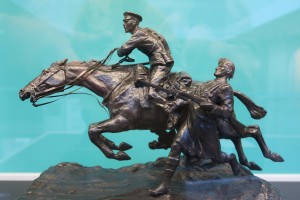
Gordons and Greys to the Front.
Painting by Stanley Berkeley.
Wiki Image.
St. Quentin 1914
Artist depictions of the stirrup charge of the 2nd Dragoons (Royal Scots Greys) and Black Watch are part of Great War mythology. It is unlikely they ever took place.
Great War artist, Caton Woodville, painted a scene illustrating the Scots Greys stirrup charge with unidentified Highlanders claiming the date of the action as 30 August 1914. Woodville’s work was based on the 1881 painting by Lady Elizabeth Butler of the 18 June 1815 charge of the 2nd Dragoons at Waterloo entitled Scotland Forever which does not include any Highland foot soldiers. An earlier depiction of a stirrup charge at Waterloo, Gordons and Greys to the Front (18 June 1815) was painted by Stanley Berkeley in 1898 also featuring the 2nd Dragoons together with soldiers of the Gordon Highlanders.

The Stirrup Charge.
Statuette by Countess Feodora Gleichen.
National Army Museum, London.
(P. Ferguson image, September 2023).
The bronze statuette by Countess Feodora Gleichen with charging horse and 2nd Dragoons Trooper shows a soldier of the Black Watch leaning back with rifle and bayonet at hand attempting to keep up. An oil painting created in 1917 by Joseph Ratcliffe Skelton depicts the same event but the Highlander is identified as a soldier of the Black Watch. Although the charge of the two regiments did not take place the 2nd Dragoons together with the 12th Lancers probably charged the German lines on 28 August 1914 during the Battle of the Guise. This charge was heralded and reported upon as one of few successes of the British Army during the first actions of the Great War. Perhaps inspired by the 2nd Dragoons 1914 action artist Feodora Gleichen’s bronze was replicated and these copies sold in aid of the Prince of Wales’s Fund for the relief of Soldiers’ and Sailors’ Families.
The galloping speed of a horse charge is estimated between 25-30 miles per hour whereas a soldier can only attain a running speed between 10-15 miles per hours.

Scotland Forever.
The painting by Lady Elizabeth Butler does not depict any Highland foot soldiers.
Wiki Image.
Tags: 12th Lancers, 1815, 1914, 2nd Dragoons (Royal Scots Greys), Art, Black Watch, Caton Woodville, Cavalry Charge, Countess Feodora Gleichen, Gordon Highlanders, Gordons and Greys to the Front, Lady Elizabeth Butler, Mythology, Prince of Wales's Fund, Royal Highland Regiment (Black Watch), Scotland Forever, Soldiers' and Sailors' Families, St. Quentin, Stanley Berkeley, Statues, Stirrup Charge, Waterloo
This entry was posted by pferguson
on Sunday, May 26th, 2024 at 9:31 pm and is filed under Art.
You can follow any responses to this entry through the RSS 2.0 feed.
You can leave a response, or trackback from your own site.
About The Author

Paul has worked with the Paradigm Motion Picture Company since 2009 as producer, historian and research specialist. Paul first met Casey and Ian WIlliams of Paradigm in April 2007 at Ieper (Ypres), Belgium when ceremonies were being held for the re-dedication of the Vimy Memorial, France.
Paul's sensitivity to film was developed at an early age seeing his first films at RCAF Zweibrucken, Germany and Sardinia. Paul returned to Canada in 1967 and was captivated by David Lean's "Lawrence of Arabia" and "Bridge on the River Kwai". Over time Paul became increasingly interested in storytelling, content development, character, direction, cinematography, narration and soundtracks.
At the University of Victoria, Paul studied and compared Japanese and Australian film and became interested in Australian film maker Peter Weir and his film "Gallipoli" (1981). Paul was inspired when he learned Weir visited the beaches, ridges and ravines of the peninsula. "Gallipoli", the film, led Paul on many journeys to sites of conflict in England, France, Belgium, Holland, Germany, Malta, Hawaii, Gallipoli, North Macedonia and Salonika.
When Paul first watched documentary filmmaker Ken Burns, "The Civil War", Paul understood how his own experience and insight could be effective and perhaps influential in film-making. Combining his knowledge of Museums and Archives, exhibitions and idea strategies with his film interests was a natural progression.
Paul thinks like a film-maker. His passion for history and storytelling brings to Paradigm an eye (and ear) to the keen and sensitive interests of; content development, the understanding of successful and relational use of collections, imagery and voice. Like Paul's favorite actor, Peter O'Toole, Paul believes in the adage “To deepen not broaden.”
While on this path Paul always remembers his grandmother whose father did not return from the Great War and how his loss shaped her life and how her experience continues to guide him.




Comments